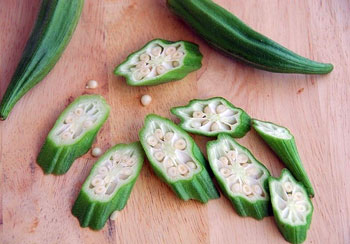Here's a guide to selecting, storing, and cooking with okra.
How do you select okra?
Choose brightly colored green pods that are firm and sport a pale peach-like fuzz. Avoid okra that is bruised, darkened, or limp. Okra is available at most supermarkets year-round, though it peaks during late summer and early autumn.
How do you store okra?
Place whole, unwashed okra in a plastic bag, or wrap in paper towel, and place in the crisper drawer of the refrigerator for up to 2-3 days.
 How do you prepare and cook okra?
How do you prepare and cook okra?
Rinse okra well and pat dry. Cut off tops and discard. Although okra can be eaten raw in salads, most people prefer it cooked. Slice for stir-fries and gumbos, or keep whole if frying. Okra can be microwaved, sauteed, broiled, roasted, baked, steamed, and grilled. To reduce sliminess, add something acidic such as vinegar or tomatoes to the okra while cooking.
Okra is most commonly found in hearty gumbos and stews. It's also wonderful in stir-fries with vegetables such as onions, red bell peppers, corn, and zucchini. It's most irresistible when dipped in buttermilk, then cornmeal, and fried to golden perfection, which is a delicacy of the American South.
What are the health benefits of okra?
Okra is a low-carb vegetable. 1 cup has only 36 calories, 0 fat, o cholesterol, 4 g carbs, and 2 g fiber. Okra is especially high in vitamins C and K, which help boost your immune system and prevent bone loss, respectively.
Quick Chicken and Okra Stew
Makes 4 servings
 Okra's characteristic sliminess functions as a natural, flavorful thickening agent in stews and soups.
Okra's characteristic sliminess functions as a natural, flavorful thickening agent in stews and soups.
1 tablespoon plus olive oil
1 medium red onion, chopped (about 1/2 cup)
3/4 pound boneless, skinless chicken breast, cut into 1-inch pieces
1 red bell pepper, sliced
1 pound okra, tops removed and sliced thickly
1/2 jalapeno, finely chopped
1 (14-oz) can diced tomatoes, with juice
1 cup low sodium vegetable broth, with 1 teaspoon cornstarch, dissolved
1/2 teaspoon cumin
salt, to taste
2 tablespoons fresh chopped cilantro, plus extra for garnish
1/4 cup queso freso cheese, plus extra for garnish*
1 cup cooked grain of your choice, such as quinoa, brown rice, or couscous
1. In a large frying pan over medium high heat, warm olive oil. Add onions; saute 3 minutes, or until lightly browned.
2. Add chicken. Saute, stirring occasionally, for 5-7 minutes, or until browned.
3. Add red bell peppers, okra, and jalapeno. Saute 3 minutes.
4. Add diced tomatoes with juice, vegetable broth with cornstarch, cumin, and salt. Raise heat to high; bring to a boil. Lower to a simmer, and cook for 7-10 minutes, or until vegetables are tender but not mushy, and the sauce has slightly thickened. Remove from heat. Stir in fresh cilantro and queso fresco. Season with salt as desired.
5. Add 1/4 cup cooked grains to each dish. Top with 1/4 of the stew. Garnish with additional cheese and cilantro. Serve immediately.
*Queso fresco, a mild flavored, soft Mexican cheese with a crumbly texture, is available at Mexican specialty markets as well as the refrigerator section of most major supermarkets. Cotija anejo, another mild-flavored Mexican cheese with a crumbly texture, is a good substitute and is also found in most major supermarkets.
Susan Russo is a free lance food writer in San Diego, California. She publishes stories, recipes, and photos on her cooking blog, Food Blogga and is a regular contributor to NPR’s Kitchen Window. She is also the author of Recipes Every Man Should Know and The Encyclopedia of Sandwiches
.
